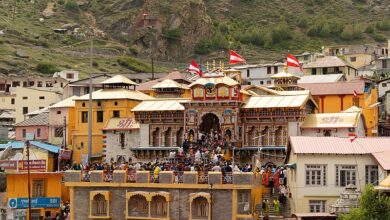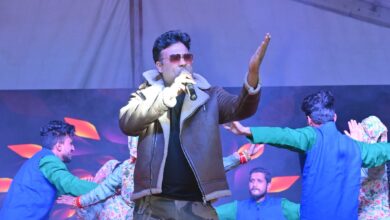Vijayadashami has many meanings

This festival is celebrated for ten types of sins such as, Work, Anger, greed, infatuation item, matsar, Ego, Laziness, Inspires the abandonment of violence and theft. Infuses hope in the midst of despair in the human mind, Which gives the message that even the widest empire of injustice and tyranny has to be defeated one day at the hands of justice and virtue. Even after establishing the kingdom of Kaliraat of sorrow, the dawn of happiness definitely comes by patiently performing one’s duties.
After worshiping Shakti for nine days, it is customary to celebrate the festival of Vijayadashami i.e. Dussehra on the tenth day of Shukla Paksha of Ashwin month. It is believed that on this day Maryada Purushottam Shri Ram killed Ravana and conquered Sri Lanka. Bhagwati Durga had conquered the demon named Mahishasura after a ten-day war of Navratri. That is why it is celebrated as a symbol of victory of truth over falsehood. And it is known as Vijayadashami. It is also called Ayudha Puja. This date is considered very sacred in Indian culture.
On this day, there is also an ancient tradition of starting new work like weapon worship and letter writing, starting a new industry, sowing seeds, etc. It is believed that in the new work started on this day, victory is definitely achieved. According to another belief, since the time of Lord Shri Ram in Tretayuga, this day of Ashwin Shukla Dashami is popular and certain as a symbol of victory and departure. In ancient times, kings used to leave for the battle on this day by praying for victory. Shri Ram had left on this day to fight with Ravana. Maratha Ratna Chhatrapati Shivaji Maharaj had also protected Hinduism by leaving against Aurangzeb on this day. There are many such examples in Indian mythological texts and history, from which it is proved that in ancient times Hindu kings used to leave for victory on this day.
At present Vijayadashami is observed as Dussehra. And the general belief is that on this day Shri Ram had hoisted the eternal flag of victory of Vedic religion by killing the demon king Ravana. That is why it is celebrated with joy and gaiety to celebrate the victory of Shri Ram by burning the effigies of Ravana, Kumbhakarna and Meghnad, calling it a symbol of victory of religion over unrighteousness. But in this regard, the truths to be verified from the detailed study of the descriptions mentioned in Ramayana and Puranic texts establish some other facts. According to Valmiki Ramayana, Shri Ram had performed the ritual of Chaturmas fast on the Rishyamook mountain of Kishkindha located in the state of Maharashtra. This ritual of Shri Ram started from the full moon of Ashadh month and continued till the ninth date of Shukla Paksha in Ashwin month.
Soon after this, on the tenth day of Ashwin’s face, known as Vijayadashami, Shri Ram, along with his cousin Lakshmana, Vanarapati Sugriva and Mahavir Hanuman, left Kishkindha towards Lanka. According to Padma Purana, Shri Ram’s war with the demon Ravana started from Paush Shukla Dwitiya and continued till Chaitra Krishna Tritiya. According to mythological belief, on Chaitra Krishna Tritiya, Shri Ram killed the ungodly Ravana. After this, on his return to Ayodhya, the coronation of Shri Ram took place on Chaitra Shukla Pratipada, the first date of Nav Samvatsar. Therefore, the talk of killing Ravana on Dussehra is not only illogical, but also against mythological beliefs. According to scholars, at the time of the advent of the Tulsikarta Ramayana, around the fifteenth century, for the first time in Kashi on the occasion of Shardiya Navratri, Ramlila was staged by Shri Ram on the tenth day i.e. on the day of Dussehra killing the demon king Ravana. The program started, which later went on as a practice.
And in a few years, this Ramlila, which runs continuously for nine days, is organized on the occasion of Shardiya Navratri in half of India including present-day Uttar Pradesh, Bihar, Jharkhand, Madhya Pradesh, Chhattisgarh, Rajasthan, Gujarat, Haryana. It became widely popular as a great means of worship and on the tenth day after Navratri, the custom of burning Ravana’s effigy by making an effigy of it with bamboo splints and thatch was carried on in Ramlila to make the episode of Ravana’s slaughter interesting and interesting. For the gaiety of Ramlila, the killing of Ravana must be enjoyable and enjoyable. And in the beginning it was staged for gaiety and laughter just for acting in Ramlila, but gradually this stage was established as a truth, as a belief that Dussehra should be celebrated. It was Shri Ram who killed Ravana.
It is noteworthy that since ancient times, Indian culture has been a worshiper of bravery, worshiping power and worshiping bravery. The victory of Shri Ram over Ravana or the victory of Durga over Mahishasura, both the stories show the importance of Shakti, and the festival of Dussehra or Vijayadashami remains as a festival of Shakti worship in both the forms. In this form, it remains the date of worship of weapons. And in this festival of victory of good over evil, Aparajita Devi is worshipped. It is believed that on Ashwin Shukla Dashami, at the time of star rise, there is a Muhurta called Vijay. This time is auspicious for all tasks. It is called Vijayadashami. According to the belief, to get victory over the enemy, as this Muhurta is auspicious, one should start on the battlefield at this time.
On this day the yoga of Shravan Nakshatra is considered even more auspicious. It is considered auspicious and good to violate the limit for kings and people holding important posts in this period, even if there is no context of war. Duryodhana defeated the Pandavas in gambling and had put a condition of exile for twelve years in the thirteenth year of exile that if the Pandavas were detected in the thirteenth year, they would have to undergo exile for twelve years again. During this period of exile, Arjuna placed his bow on the trunk of a Shami tree and himself took a job in the garb of Vrihanla at the house of King Virata of Viratnagar. When Virat’s son Uttar asked Arjuna for cooperation for cow protection, Arjuna lifted his weapon kept on the Shami tree and won victory over the enemies on this day. It is also believed that on the day of Vijayadashami, the Shami tree proclaimed the victory of Lord Rama while leaving for his ascent to Lanka. This is the reason why Shami Puja is performed during Vijayakal. Since ancient times, it has been a tradition in India to generate fire from two branches (aranis) of Ashwattha (Peepal) grown in Shami tree for Vedic sacrifices. Fire signifies strength and courage. The sticks of Shami wood are helpful in the generation of fire. There are many such mantras in the Vedic hymns, in which descriptions related to the purity and usefulness of Agni and Shami are available.
It is worth mentioning that like Rakshabandhan, Deepawali and Holi festival, Vijayadashami is also prevalent, alive and festive in Indian culture since time immemorial. It has fascinated, energized, adored and delighted the Indian society since the Vedic times. But it is true that the Vedic importance of Vijayadashami has now reduced to a negligible value. The method of celebrating it – the legislation deteriorated, the traditions changed, and changed as a new practice. This happened many times. The farmer here does not swell with happiness, gaiety and enthusiasm when he comes home to his new crop products in the agricultural country of India. On this joyous occasion, he thanks the Lord for his grace, expresses gratitude and offers prayers. In India, since ancient times, there was a custom of offering new food grains on this occasion. Even today it continues unabated in many parts of the country and in Vedic families. Along with this, there are acts of hanging green and unripe earrings of paddy on the door and keeping wheat, yew etc. on the ears, head or turban.
In the course of various changes from place to place, being customary in the time period of thousands of years, this festival has been organized and enhanced in its different forms over time. At present, this festival is celebrated in different forms in different parts of the country with great enthusiasm, enthusiasm and gaiety. On this date, fairs are held at every place, Ramlila is organized, effigies of Ravana are made and burnt. The detailed description of this festival of Vijayadashami has been given in Hemadri, Sindhunirnaya, Purushartha Chintamani, Vratraj, Kalatattvavichan, Dharmasindhu etc.
In fact, Dussehra, the festival of joy and victory, is a festival showing the harmony of power and power. The festival of Dussehra is celebrated for the manifestation of bravery in the blood of the individual and the society. This festival inspires the renunciation of ten types of sins, viz. In the midst of the despair prevailing in the human mind, it communicates hope, which gives the message that even the widest empire of injustice and tyranny has to be defeated by justice and virtue one day or the other. Even after establishing the kingdom of Kaliraat of sorrow, the dawn of happiness definitely comes by patiently performing one’s duties.





